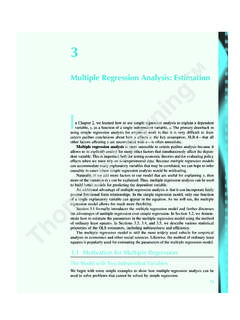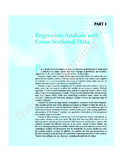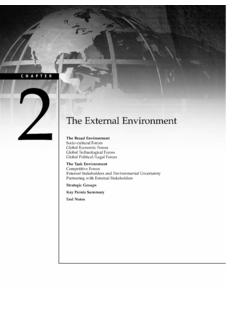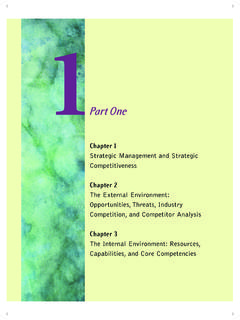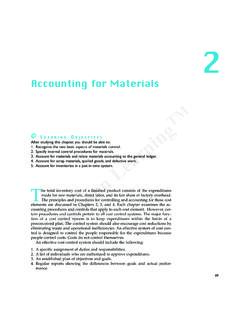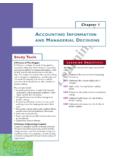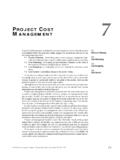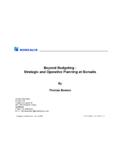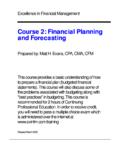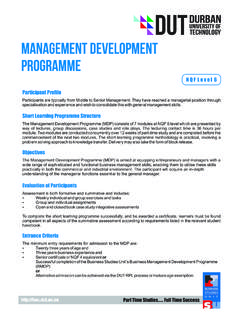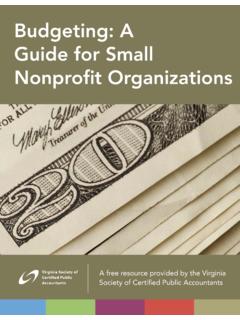Transcription of Capital Budgeting: The Basics - Cengage Learning
1 Chapter 11 Capital budgeting : The Basics (1 + r)tRisk-AdjustedCost of Capital (WACC) project FreeCash Flows (FCFt)VA L U E=N t=0 CFtComponent CostsFirm RiskProject RiskCountry RiskRequired InvestmentSales RevenuesOperating CostsTa xe sThe textbook s Website, ,contains an Excelfile that will guideyou through thechapter s calcula-tions. The file forthis chapter ,, and we encourageyou to open the fileand follow along asyou read the generate cash flows by using assets without assets, there would beno sales, profits, or cash flows.
2 However, some potential asset acquisitionsrepresent good investments while others are likely to be losers, and themost successful firms are those that make the best asset investment decisions. Capital budgeting is the name given to the asset investment decision , Capital budgeting decisions are no different than decisions relatingto stocks and bonds. When evaluating securities, cash flows (coupon payments,dividends, etc.) are estimated and then discounted at an appropriate rate (theYTM or YTC for bonds and the required return for stocks) to find the presentvalue of the cash flow stream.
3 In Capital budgeting , projects require an initialinvestment (perhaps spread over multiple years) and then they produce positiveoperating cash flows over some period. These cash flows are then discountedback to the present at a weighted average cost of Capital (WACC) sufficient tocompensate investors for bearing the risk inherent in the Capital budgeting process requires coordination between several depart-ments within the company. Most projects involve large initial investments andhave an ongoing need for funding to cover operating costs throughout their must estimate the product demand and determine optimal prices andquantities so as to maximize profits.
4 The evolving nature of global markets com-plicates these decisions. In the past, firms generally operated and sold only intheir home countries, with markets in other countries served primarily throughexports. Today, though, multinational firms operate in both industrial economiesand emerging markets, and the complexities of producing and selling in manysovereign countries make the analyses of investment projects much more 8/13/04 11:29 AM Page 321 Conceptually, Capital budgeting is similar for both purely domestic and multinationalcompanies, and in both cases we apply our basic valuation equation.
5 We first estimate theproject s investment requirements, both for acquiring productive assets and the relatedoperating working Capital , and this typically results in a negative cash flow at t 0. Forlarge projects that take several years to complete, there may be negative cash flows forseveral years, and in this instance the project s cost is calculated as the present value(PV) of those negative cash flows. Next, we estimate the FCFs for each year and find theirpresent value. Finally, we estimate funds the firm can recover from selling the equipmentand liquidating the working Capital at the end of the project s operating life (the terminalvalue) and find their present value.
6 The difference between the PV of the positive cashinflows and the PV of the project s investment cost is defined as the net present value, orNPV, and it represents the value the proposed project is expected to add to the firm. If aproject s NPV is positive, then it increases the firm s value and should be the basic tenets of domestic Capital budgeting still hold, international capitalbudgeting must consider some additional factors. In particular, multinationals must con-tend with different accounting and tax systems, exchange rate fluctuations, and the repa-triation of funds from foreign investments back to the parent.
7 A further complicationarises because the analysis can be performed from either a local subsidiary s perspectiveor from the parent s home market perspective. The focus in either case should be on max-imizing the wealth of the parent s shareholders, but the analysis itself is different depend-ing on the perspective taken. This chapter covers the Basics of Capital budgeting in aglobal setting, while the next one goes on to bring in risk analysis and the role of realoptions in the Capital budgeting decision of Capital BudgetingCapital budgetingis the decision process used to identify those investment projectsthat are likely to add value to the firm, and it is perhaps the most important taskfaced by financial managers and their staffs.
8 First, a firm s Capital budgeting deci-sions define its strategic direction because moves into new products, services, ormarkets must be preceded by Capital expenditures. Second, the results of capitalbudgeting decisions continue for many years, thus reducing future flexibility. Third,poor Capital budgeting can have serious financial consequences. If the firm investstoo much, it will incur unnecessarily high depreciation and other expenses. On theother hand, if it does not invest enough, its equipment and computer software willbecome obsolete, and the firm will be unable to produce competitively.
9 Also, if it hasinadequate capacity, it may lose market share to rival firms, and regaining lost cus-tomers requires heavy selling expenses, price reductions, or product improvements,all of which are valuation concepts are also applied in Capital budgeting . However,instead of investors selecting stocks and bonds from those available in the securitiesmarket, Capital budgeting projects are created by the firm. For example, a sales rep-resentative may report that customers are asking for a product that the companydoes not currently produce.
10 The sales manager then consults with the marketingresearch group to determine demand for the proposed product. If a significant mar-ket exists, cost accountants and engineers will estimate production costs. If man-agement concludes that the product can generate sufficient profit, it will be formallyproposed, and a project analysis will be conducted to verify that it will add value tothe 11 Capital budgeting : The BasicsCapital BudgetingThe process ofplanning expendi-tures on assetswhose cash flowsare expected toextend beyondone 8/13/04 11.


